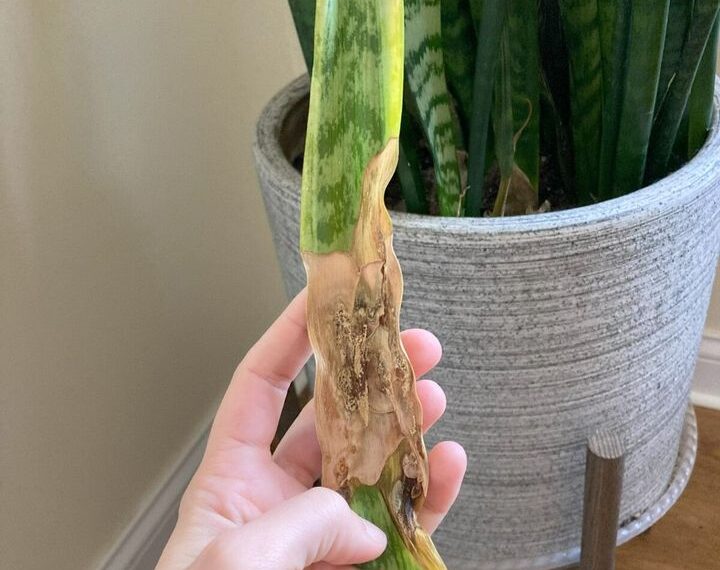The Snake Plant (Sansevieria), also known as Mother-in-Law’s Tongue, is a popular houseplant known for its striking appearance, resilience, and air-purifying qualities. If you’ve recently gotten one or have had one for a while and want to make sure it thrives, there are some key things you need to know about its care. Here are 10 essential tips to help your snake plant grow strong and healthy.
1. Choose the Right Location
Snake plants are known for being highly adaptable to different lighting conditions, but they do best in bright, indirect light. While they can survive in low light, prolonged exposure to dim conditions may slow their growth and make the leaves less vibrant. If possible, place your snake plant near a window with filtered light, but avoid direct sunlight, which can scorch the leaves.
Pro Tip:
If you notice your snake plant becoming leggy (long, stretched-out leaves), it’s likely reaching for more light and may need a brighter spot.
2. Water Sparingly
One of the most common mistakes made with snake plants is overwatering. These plants are native to arid regions and are accustomed to dry conditions, so they don’t need frequent watering. Let the soil dry out completely between waterings, especially in winter when the plant’s growth slows down.
Watering Guide:
- Spring and Summer: Water once every 2-3 weeks or when the top inch of soil is dry.
- Fall and Winter: Water once a month or even less frequently, depending on the indoor climate.
Warning:
Overwatering can cause root rot, a condition that’s often fatal for snake plants. Make sure your pot has drainage holes to allow excess water to escape.
3. Use Well-Draining Soil
Snake plants need well-draining soil to prevent root rot. A cactus or succulent potting mix is ideal since it drains faster than regular potting soil. You can also create your own mix by combining equal parts of regular potting soil and coarse sand or perlite. This ensures that water doesn’t sit around the roots for too long.
Soil Tip:
If you repot your snake plant, ensure the new soil is light and airy. Heavy, compacted soil holds onto water and can suffocate the roots.
4. Monitor Temperature and Humidity
Snake plants are fairly tolerant of varying temperatures but prefer a range between 60°F and 85°F (16°C – 29°C). They’re not frost-tolerant, so make sure they’re kept away from cold drafts and air-conditioning vents during winter. Humidity isn’t a major concern, as snake plants thrive in both dry and moderately humid environments.
Warning:
Avoid placing your snake plant in temperatures below 50°F (10°C), as the cold can damage its leaves and stunt growth.
5. Fertilize Occasionally
Snake plants don’t require frequent feeding, but they can benefit from occasional fertilization during the growing season (spring and summer). A balanced liquid fertilizer, diluted to half strength, once a month is sufficient. Skip fertilizing in the fall and winter when the plant enters its dormant phase.
Fertilizing Tip:
Over-fertilizing can lead to an accumulation of salts in the soil, which can harm your plant. Always follow the instructions on your fertilizer package.
6. Repot When Necessary
Snake plants are slow-growing and don’t need frequent repotting. However, if you notice roots growing out of the drainage holes or the plant becoming top-heavy, it may be time to move it to a slightly larger pot. Generally, repotting every 2-3 years is enough.
Repotting Guide:
- Choose a pot that’s only 1-2 inches wider than the current one.
- Use fresh, well-draining soil.
- Be gentle with the roots, especially if your plant has been in the same pot for a long time.
7. Prune to Maintain Shape
While snake plants don’t require regular pruning, you can trim them if they become too tall, leggy, or if any leaves are damaged or dead. Use sharp, clean scissors or pruning shears to cut the leaves at the base. Pruning also encourages new growth, helping to keep your plant looking fresh and healthy.
Pruning Tip:
If your plant grows too tall for your liking, prune it back gradually instead of removing large sections at once. This helps maintain its overall health.
8. Propagate Easily
Snake plants are incredibly easy to propagate, making them a great plant to share with friends or to expand your indoor garden. You can propagate them through leaf cuttings or by dividing the plant at the root (rhizome division).
Propagation Methods:
- Leaf Cuttings: Cut a healthy leaf into 3-4 inch sections, let the cut ends dry for a day, then plant them in moist soil. It may take several weeks for roots to form.
- Rhizome Division: Gently remove the plant from its pot and cut the rootball into sections, ensuring each piece has some roots and leaves attached. Repot the divisions into separate containers.
9. Beware of Pests
While snake plants are relatively pest-resistant, they can occasionally attract common houseplant pests such as spider mites, mealybugs, or scale. Keep an eye out for small insects or sticky residue on the leaves. If you spot any pests, treat your plant with insecticidal soap or neem oil, and wipe the leaves clean.
Preventative Tip:
Regularly dust your snake plant’s leaves to keep them clean and deter pests from making a home there.
10. Health Benefits
Snake plants aren’t just easy to care for; they also offer several health benefits. They are known to filter toxins from the air, including formaldehyde, benzene, and trichloroethylene, which makes them excellent for improving indoor air quality. Plus, they release oxygen at night, making them a good choice for bedrooms.
Health Tip:
To maximize the air-purifying benefits of your snake plant, place it in rooms where you spend the most time, like your living room, office, or bedroom.
Conclusion
Snake plants are one of the easiest and most rewarding houseplants to care for, making them perfect for both beginners and seasoned gardeners alike. By following these 10 simple tips, you’ll ensure your snake plant thrives for years to come. From proper lighting and watering to repotting and propagation, you can enjoy a healthy, vibrant snake plant that not only beautifies your home but also improves your air quality.




